Flanders, (1523-1605)
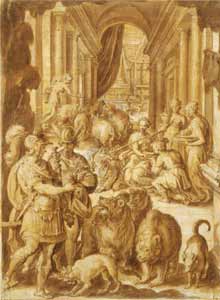
-
Odysseus, Mercury and Circe
- (1570) pen and ink with wash and white heightening
over black chalk under-drawing on yellow washed paper - 11.8 x 8.7 in. (29.9 x 22 cm.)
- The Royal Collection, London
-
Editor’s Note:
This is a study for a painting in Francesco de’ Medici’s cabinet room or studiolo in the Palazzo Vecchio. See the framed oval image below for the final painting.
A breakdown of the scene:
Left Foreground: Odysseus enters Circe’s palace to release his crew. He is protected by a ‘moly root’ given by Mercury (shown with the winged helmet).
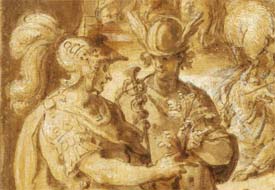
Center Right: Circe is shown feeding one of the crewmen a potion that will turn him into a pig. To her left is a man mid-transformation, on all fours with a pig’s head.
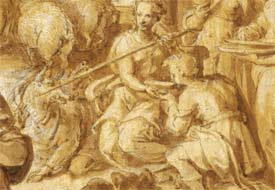
Middle ground: A servant feeds swine that we presume are crewmen already transformed.
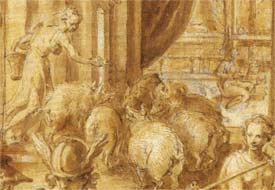
Background: Penelope, the wife of Odysseus, is seated at her loom as she passes the years waiting for his return.
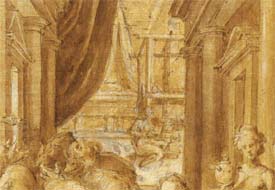
One further note: Homer’s Odyssey mentions only pigs, but though the popularity of the works by authors after Homer, Circe is ascribed with transformative powers that can turn Odysseus’ crew into a wide variety of creatures that even include oysters and elephants. Here a lion, a bear, a wolf and a fox are also represented.
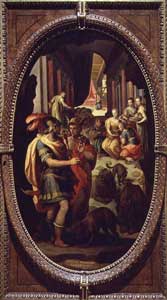
-
Odysseus, Mercury and Circe
- (1572), oil on canvas
- Studiolo in the Palazzo Vecchio, Florence
-
Editor’s Note:
This painting is Stradanus’ adaptation of his original pen and ink drawing above in order to accommodate the oval frame that was added as part of the final design. The scene breakdown above still applies.
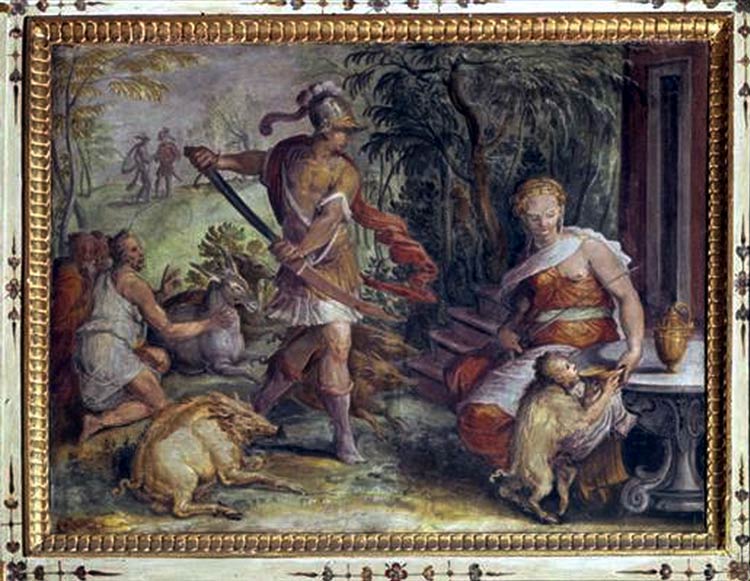
-
Odysseus and Circe
- (1562), fresco
- Sala di Penelope, Palazzo Vecchio, Florence
-
Editor’s Note:
On the ceiling in the Sala di Penelope (Room of Penelope) is a fresco by Stradanus of Penelope at the loom. The image above is a segment of a continuous frieze of frescos that surrounds the room just below the ceiling. The theme is a composition of landscapes and seascapes of mythological content from the Odyssey. This room was originally intended as a study for Eleanora of Toledo (1522-1562), wife of Grand Duke Cosimo I de ‘Medici (1519-1574). [DES-01/11]
About the Artist
Giovanni Stradano (1523-1605) was a Flanders-born mannerist artist, print maker and tapestry designer active mainly in 16th century Florence. Born Jan van der Straet (or van der Straat), he travelled as a young man from Flanders to Italy where he adopted the name Giovanni Stradanus (or Stradano or Stratesis).
Stradano began his training in the shop of his father, then in Antwerp with Pieter Aertsen. Stradano reached Italy by 1550 and worked in Venice, Florence and Rome. He entered in the service of the Medici Dukes and Giorgio Vasari. He also worked with Francesco Salviati in the decoration of the Vatican Belvedere and also worked in the Palazzo Vecchio and the villa of Poggio a Caiano. One of own students was the engraver Antonio Tempesta.
From 1567 to 1577, Stradanus designed the Hunting Scene tapestry for Cosimo’s villa at Poggio a Caiano. The cartoons drew immediate success and were reproduced as engravings and published by Antwerp print makers on after his death. [DES-01/11]
